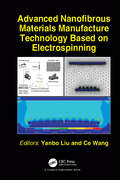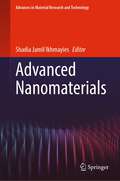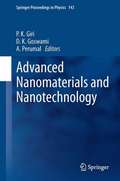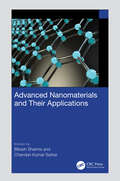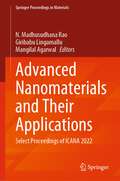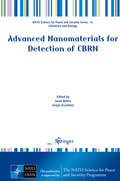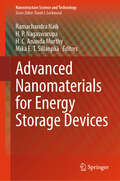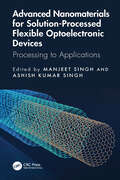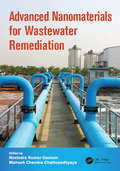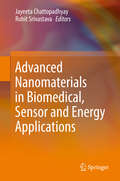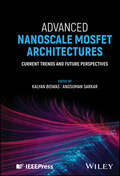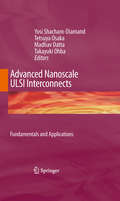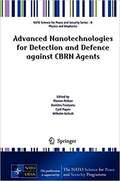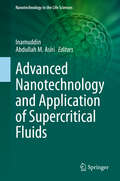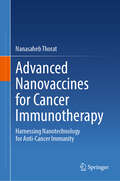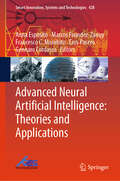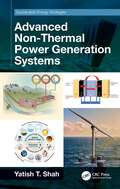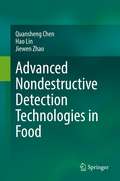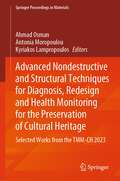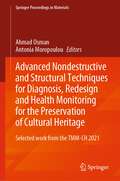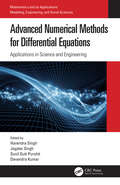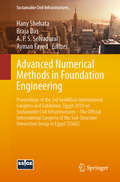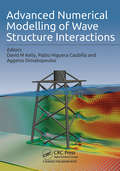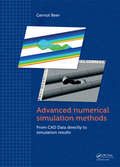- Table View
- List View
Advanced Nanofibrous Materials Manufacture Technology based on Electrospinning
by Ce Wang Yanbo LiuThis book comprehensively addresses advanced nanofiber manufacturing based on electrospinning technology. The principles, relationships between process parameters and structure, morphology and performance of electrospun nanofibers and nanomaterials, and the methods for enhanced field intensity and uniform distribution are discussed. The electric field intensity and distribution during electrospinning is also analyzed based on finite element analysis on both the needle and the needleless electrospinning. Furthermore, the modification techniques for improved nanomaterials strength are covered, aiming to provide effective avenues towards the manufacture of stronger nanofiber or nanomaterial products.
Advanced Nanomaterials (Advances in Material Research and Technology)
by Shadia Jamil IkhmayiesThis book covers synthesis, characterization, and applications of diverse types of nanomaterials. Specifically, it describes carbon, graphene, and graphene oxide-based nanomaterials and their use for environmental remediation; rare-earth ions-activated nanophosphors and their application; lanthanide-based oxides as advanced nanostructured materials for organic decontamination; and advanced functional nanomaterials for pollutant sensing and water remediation. The chapters explore the use of nanomaterials in solid-phase extraction technique, design of colorimetric sensor based on gold nanoparticles, optical sources and waveguides based on flexible 1D nanomaterials, synthesis and property characterization of 2D materials with applications, and the scale effects on the value of the surface energy of a solid. The developments of some nanomaterials such as zinc and nickel sulfides as photocatalysts and electrocatalysts, effects of reducing size and incorporation of nanoadditives, advanced carbon nanomaterials such as carbon nanotubes, carbon nanofibers, and graphene and its derivations as adsorbents, and carbon spheres and carbon soot for tribological applications are also presented in this book. In addition, nanomaterials for concrete coating applications and advances in the processing of high-entropy alloys by means of mechanical alloying are also covered. Subsequently, the use of nanomaterials in endodontics and the use of nanotechnology strategies to enhance restorative resin-based dental nanomaterials are reported.
Advanced Nanomaterials and Nanotechnology: Proceedings of the 2nd International Conference on Advanced Nanomaterials and Nanotechnology, Dec 8-10, 2011, Guwahati, India (Springer Proceedings in Physics #143)
by A. Perumal D. K. Goswami P. K. GiriNanoscale science and technology have occupied centre stage globally in modern scientific research and discourses in the early twenty first century. The enabling nature of the technology makes it important in modern electronics, computing, materials, healthcare, energy and the environment. This volume contains selected articles presented (as Invited/Oral/Poster presentations) at the 2nd international conference on advanced materials and nanotechnology (ICANN-2011) held recently at the Indian Institute of Technology Guwahati, during Dec 8-10, 2011. The list of topics covered in this proceedings include: Synthesis and self assembly of nanomaterials Nanoscale characterisation Nanophotonics & Nanoelectronics Nanobiotechnology Nanocomposites F Nanomagnetism Nanomaterials for Energy Computational Nanotechnology Commercialization of Nanotechnology The conference was represented by around 400 participants from several countries including delegates invited from USA, Germany, Japan, UK, Taiwan, Italy, Singapore, India etc.
Advanced Nanomaterials and Their Applications
by Chandan Kumar Sarkar Bikash SharmaThis book covers various facets of nanomaterials and their applications including low-dimensional materials along with discussions on in vitro cell imaging, bioanalyses, UV laser applications of scheelite-type nanomaterials, and nanosized cyanobridged metal-organic frameworks, including high spin transition metal ions. It explains transition metal dichalcogenides and magnetic tunnel junction devices as an alternative to complementary metal-oxide semiconductors. One of the main aims of this book is to grow interest in the atomistic simulation process and characterization of these nanoscale devices. Details the recent advances in the application of nanomaterials for nanoelectronics devices, sensors, and memories Describes the first-principles approach to ultrasensitive electrically doped biosensors Discusses the application of nanomaterials in spintronic devices, specifically magnetic tunnel junction devices with new architectures Covers nanomaterials in water purification and conducting polymer nanocomposites in electrochemical supercapacitors Presents the theoretical background of next-generation MRI contrast agents with nanosized cyanobridged metal-organic frameworks including high spin transition metal ions This book is aimed at researchers and graduate students of materials engineering and nanoelectronics.
Advanced Nanomaterials and Their Applications: Select Proceedings of ICANA 2022 (Springer Proceedings in Materials #22)
by N. Madhusudhana Rao Giribabu Lingamallu Mangilal AgarwalThis book comprises select proceedings of the International Conference on Advanced Nanomaterials and Applications (ICANA 2022) and presents recent developments in the fields of nanoscale sciences. The topics covered in this book include energy storage and conversion, bio- and healthcare materials, sensors and actuators, functional materials, optical materials, and computational and simulation methods. This book is useful for researchers and professionals working in the various fields of nanotechnology.
Advanced Nanomaterials for Detection of CBRN (NATO Science for Peace and Security Series A: Chemistry and Biology)
by Janez Bonča Sergei KruchininThis book is devoted to advanced materials and perspective sensors, which is one of the most important problems in nanotechnology and security. This book is useful for researchers, scientist and graduate students in the fields of solid state physics, nanotechnology and security.
Advanced Nanomaterials for Energy Storage Devices (Nanostructure Science and Technology)
by H. P. Nagaswarupa H. C. Ananda Murthy Ramachandra Naik Mika E. T. SillanpääThis contributed volume provides a comprehensive overview of nanomaterials tailored for energy storage applications, covering fundamental concepts such as computational design and modeling, synthesis techniques, characterization methods, and advanced strategies for enhancing energy storage performance. Through case studies, it demonstrates the practical applications of nanomaterials in specific energy storage devices, highlighting their significance. The book also explores advanced electrode types and fabrication techniques, addresses challenges and opportunities in the field, and offers insights into future perspectives and emerging trends. It serves as an essential resource for researchers, scientists, engineers, and students interested in materials science, nanotechnology, and energy storage, providing a thorough understanding of the latest advancements and potential developments in the field.
Advanced Nanomaterials for Solution-Processed Flexible Optoelectronic Devices: Processing to Applications
by Manjeet Singh Ashish Kumar SinghThis book covers the recent advancements in the fabrication of flexible optoelectronic devices using advanced nanomaterials. It provides information on how to process non-layered advanced nanomaterials such as carbon nanotubes, fullerenes, nanowires, colloidal quantum dots, inorganic halide perovskite, perovskite nanomaterials stabilized in porous materials, doped-ZnO, lead chalcogenide nano crystals for the easy fabrication of the optoelectronic devices at an industrial scale.Advanced Nanomaterials for Solution-Processed Flexible Optoelectronic Devices provides up-to-date knowledge centered on the various non-layered nanomaterials and their different types of application in optoelectronic device fabrication. The first few chapters focus on the processing and applications of carbon nanotubes and fullerenes into devices for photovoltaics. Throughout the book the authors demonstrate not only device fabrication but processing of the advanced nanomaterials to make them suitable for wide applications as different components in optoelectronics. The book also presents discussions on the current challenges and future perspective for the proper processing and utilization of advanced nanomaterials for the fabrication of devices.This book is intended for graduate students, researchers, and engineers working in the area of advanced nanomaterials, energy conversion, energy storage, sensors, and different types of optoelectronic devices.
Advanced Nanomaterials for Wastewater Remediation (Advances in Water and Wastewater Transport and Treatment)
by Ravindra Kumar Gautam and Mahesh Chandra ChattopadhyayaContamination of aqueous environments by hazardous chemical compounds is the direct cause of the decline of safe clean water supply throughout the globe. The use of unconventional water sources such as treated wastewater will be a new norm. Emerging nanotechnological innovations have great potential for wastewater remediation processes. Applications that use smart nanomaterials of inorganic and organic origin improve treatment efficiency and lower energy requirements. This book describes the synthesis, fabrication, and application of advanced nanomaterials in water treatment processes; their adsorption, transformation into low toxic forms, or degradation phenomena, and the adsorption and separation of hazardous dyes, organic pollutants, heavy metals and metalloids from aqueous solutions. It explains the use of different categories of nanomaterials for various pollutants and enhances understanding of nanotechnology-based water remediation to make it less toxic and reusable.
Advanced Nanomaterials in Biomedical, Sensor and Energy Applications
by Rohit Srivastava Jayeeta ChattopadhyayThis book is aimed at all those who are interested to understand the current research going on in nanomaterial science from the perspectives of biomedical, sensorial and energy applications including all aspects of physical chemist, chemical engineers and material scientist. Nanoscience and nanotechnology are at the forefront of modern research. The fast growing economy in this area requires experts with outstanding knowledge of nanoscience in combination with the skills to apply this knowledge in new products. A multidisciplinary scientific education is crucial to provide industry and research institutes with top quality experts who have a generic background in the different sub disciplines such as electronics, physics, chemistry, material science, biotechnology. The book covers recent advancement in nanoscience and nanotechnology particularly highlights the utilization of different types of nanomaterials in biomedical field, sensor and in the energy application. On the other hand, it leads the reader to the most significant recent developments in research. It provides a broad and in-depth coverage of the nanoscale materials and its depth significant applications.
Advanced Nanoscale MOSFET Architectures: Current Trends and Future Perspectives
by Angsuman Sarkar Kalyan BiswasComprehensive reference on the fundamental principles and basic physics dictating metal–oxide–semiconductor field-effect transistor (MOSFET) operation Advanced Nanoscale MOSFET Architectures provides an in-depth review of modern metal–oxide–semiconductor field-effect transistor (MOSFET) device technologies and advancements, with information on their operation, various architectures, fabrication, materials, modeling and simulation methods, circuit applications, and other aspects related to nanoscale MOSFET technology. The text begins with an introduction to the foundational technology before moving on to describe challenges associated with the scaling of nanoscale devices. Other topics covered include device physics and operation, strain engineering for highly scaled MOSFETs, tunnel FET, graphene based field effect transistors, and more. The text also compares silicon bulk and devices, nanosheet transistors and introduces low-power circuit design using advanced MOSFETs. Additional topics covered include: High-k gate dielectrics and metal gate electrodes for multi-gate MOSFETs, covering gate stack processing and metal gate modification Strain engineering in 3D complementary metal-oxide semiconductors (CMOS) and its scaling impact, and strain engineering in silicon–germanium (SiGe) FinFET and its challenges and future perspectives TCAD simulation of multi-gate MOSFET, covering model calibration and device performance for analog and RF applications Description of the design of an analog amplifier circuit using digital CMOS technology of SCL for ultra-low power VLSI applications Advanced Nanoscale MOSFET Architectures helps readers understand device physics and design of new structures and material compositions, making it an important resource for the researchers and professionals who are carrying out research in the field, along with students in related programs of study.
Advanced Nanoscale ULSI Interconnects: Fundamentals And Applications
by Madhav Datta Yosi Shacham-Diamand Takayuki Ohba Tetsuya OsakaThis book presents one of the new frontiers of modern electrochemistry science and technology: electrochemical processes for Ultra-large-Scale Integration (ULSI) technology for Integrated Circuits (ICs) applications. This is a field which influences our day to day life and still presents major technological and scientific challenges. This book reviews ULSI technology in light of all the novel electrochemical processes which make ULSI technology possible. The book will focus on sub-100 nm CMOS technology, mainly on copper-based metallization.
Advanced Nanotechnologies for Detection and Defence against CBRN Agents (NATO Science For Peace And Security Series B: Physics and Biophysics)
by Wilhelm Kulisch Cyril Popov Plamen Petkov Dumitru TsiulyanuProvides an up-to-date overview on various nanostructured materials and nanotechnologies for different security and safety related areas. <P><P>The content spans synthesis, characterization and diverse applications of nanoscaled materials.<P> Includes contributions from physicists, chemists, material scientists, engineers and biologists.<P>This volume gives a broad overview of advanced technologies for detection and defence against chemical, biological, radiological and nuclear (CBRN) agents. It provides chapters addressing the preparation and characterization of different nanoscale materials (metals, oxides, glasses, polymers, carbon-based, etc.) and their applications in fields related to security and safety. In addition, it presents an interdisciplinary approach as the contributors come from different areas of research, such as physics, chemistry, engineering, materials science and biology. A major feature of the book is the combination of longer chapters introducing the basic knowledge on a certain topic, and shorter contributions highlighting specific applications in different security areas.
Advanced Nanotechnology and Application of Supercritical Fluids (Nanotechnology in the Life Sciences)
by Inamuddin Abdullah M. AsiriGlobalization and industrialization involve a number of reactions, products, extractions, and separations that require the use of organic solvents. These solvents are responsible for a number of ecological concerns, including atmospheric and land toxicity. Conventional organic solvents are regarded as volatile organic compounds; some are even limited due to their potential for ozone layer depletion. While supercritical liquids exhibit physical properties that could make them ideal substitutes for these volatile compounds, there is particular interest in the use of carbon dioxide as a solvent of crude material. In particular, carbon dioxide has apparent ‘green’ properties, like its noncombustible nature, the fact that it is generally nonpoisonous, and its relative inertness. Thus, the use of supercritical carbon dioxide can provide practical improvements to the sustainability of industrial products and processes. This book provides in-depth literature in the area of industrial green processes, focusing on the separation, purification, and extraction of compounds utilizing supercritical carbon dioxide as a green solvent.
Advanced Nanovaccines for Cancer Immunotherapy: Harnessing Nanotechnology for Anti-Cancer Immunity
by Nanasaheb ThoratThis book provides an in-depth look into the application of cancer vaccines in the treatment of cancer, which is being enhanced by advances in nanotechnology. Delving into nanovaccine science and showcasing its potential in the fight against cancer, immunotherapy explores the possibilities of using nano-sized drugs to boost the body's immune system and combat cancerous cells. Cancer vaccines are becoming increasingly diverse – this book reveals their different types and how they are being developed. Chapter by chapter, it offers invaluable knowledge in this burgeoning field. Readers will learn about the potential of nanomedicine for improved vaccine delivery, overcoming drug resistance, and clinical applications. With its problem-based approach and state-of-the-art technologies, this book is an excellent and informative resource for researchers, clinicians, and students seeking to apply nanotechnology in the fight against this deadly disease.
Advanced Network Technologies and Intelligent Computing: First International Conference, ANTIC 2021, Varanasi, India, December 17–18, 2021, Proceedings (Communications in Computer and Information Science #1534)
by Isaac Woungang Anshul Verma Sanjay Kumar Dhurandher Pradeepika Verma Kiran Kumar PattanaikThis volume constitutes the selected papers presented at the First International Conference on Advanced Network Technologies and Intelligent Computing, ANTIC 2021, hed in Varanasi, India, in December 2021. Due to the COVID-19 pandemic the conference was held online. The 61 papers presented were thoroughly reviewed and selected from 593 submissions. They are organized in topical sections on advanced network technologies and intelligent computing. ;
Advanced Neural Artificial Intelligence: Theories and Applications (Smart Innovation, Systems and Technologies #428)
by Anna Esposito Marcos Faundez-Zanuy Gennaro Cordasco Eros Pasero Francesco C. MorabitoThis book illustrates recent advances in Neural Artificial Intelligent Theories and Applications discussed by selected papers presented at 30th edition of the International Workshops on Neural Network (WIRN 2023). The book discusses novel technologies for unsupervised multimodal complex autonomous systems using new generation of AI algorithms. The book also reports on advanced acoustical, perceptual, and psychological analysis of verbal and non-verbal communication of signals originating in spontaneous face-to-face interaction, automatic procedures capable of recognizing human emotional states, and applications improving the performance of human–machine interaction for the deployment of socially and emotionally believable assistive technologies.
Advanced Non-Thermal Power Generation Systems (Sustainable Energy Strategies)
by Yatish T. ShahGenerally, sources for power generation are broken down into two categories: thermal and non-thermal. Thermal sources for power generation include combustion, geothermal, solar, nuclear, and waste heat, which essentially provide heat as a means for power generation. This book examines non-thermal (mechanical, electrochemical, nanoscale self-powered, and hybrid) sources of power generation and emphasizes recent advances in distributed power generation systems. Key Features Details recent advances made in wind power, including onshore, offshore, fixed and floating platform, and air wind energy systems, and offers detailed assessments of progress Covers advances in generation of hydropower, exploring dam hydropower, novel wave energy converters, and novel systems and turbines for hydrokinetic energy conversion to power Examines all types of fuel cells and their multi-functional roles, along with hybrid fuel cell systems in complete detail Explores advances in the development of self-powered nanogenerators for use in portable, wearable, and implantable power electronics Focuses on technologies with the best commercial possibilities and provides perspectives on future challenges that need to be solved This book will be of value to all researchers in academia, industry, and government interested in pursuing power generation technologies and seeking a comprehensive understanding of available and emerging non-thermal power generation sources. Readers who are interested in learning about thermal power generation sources can find it in the author’s companion text Advanced Power Generation Systems: Thermal Sources (2023).
Advanced Nondestructive Detection Technologies in Food
by Jiewen Zhao Quansheng Chen Hao LinThis book comprehensively introduces non-destructive methods for food quality (i.e. external, internal, sensory, components, and microbiological indicators) detection, through optics, acoustics, chemistry, imaging, and bionic sensing. It highlights in-situ detection of food quality and safety, including principles, signal processing, and analysis of data, non-destructive detection system, and application in the food industry for each method. First, this book introduces the principles and characteristics of various food non-destructive methods. As non-destructive measurements always involve obtaining big data for each testing, this book also describes in detail the signal and big data processing for each non-destructive method. The chapters also introduce the rapid portable detection equipment for food and agricultural products developed in recent years, as well as the intelligent monitoring equipment in the process of food processing. Relevant application cases are provided to help readers better understanding how to apply non-destructive technology for food quality detection. In the noninvasive measurement of food quality, this book has a systematic introduction of the detection principle, data processing, and rapid detection system, in-field detection case studies. This book is novel and practical and can be used as a professional textbook for undergraduates majoring in food science and engineering. It can also be used as a reference book for scientific research and technical personnel engaged in the field of food quality and safety detection.
Advanced Nondestructive and Structural Techniques for Diagnosis, Redesign and Health Monitoring for the Preservation of Cultural Heritage: Selected Works from the TMM-CH 2023 (Springer Proceedings in Materials #33)
by Antonia Moropoulou Ahmad Osman Kyriakos LampropoulosThis book comprises the proceedings of the third TMM_CH International Conference on "Transdisciplinary Multispectral Modelling and Cooperation for the Preservation of Cultural Heritage." This book showcases the latest advancements in non-destructive testing and structural techniques across a wide range of applications within the realm of cultural heritage. The conference, held at the esteemed Eugenides Foundation in Athens, Greece, brought together scientists, engineers, architects, archeologists, conservators, geologists, art historians, and other stakeholders. Thirteen sessions and panel discussions featuring 142 esteemed panelists provided a platform for the exchange of ideas. With a significant online presence and approximately 50,000 online viewers, the conference had a profound impact on a global scale. This book serves as a valuable resource, presenting recent scientific breakthroughs, non-destructive techniques, and technologies that contribute to the holistic preservation of our world's cultural heritage.
Advanced Nondestructive and Structural Techniques for Diagnosis, Redesign and Health Monitoring for the Preservation of Cultural Heritage: Selected work from the TMM-CH 2021 (Springer Proceedings in Materials #16)
by Antonia Moropoulou Ahmad OsmanBased on the success of the first published book on “Nondestructive Evaluation and Monitoring Technologies, Documentation, Diagnosis and Preservation of Cultural Heritage”, this book will includes peer reviewed papers submitted to the conference in form of single independent chapters. Each chapter will highlight the benefits of one or more Non-Destructive Testing (NDT) methods, image processing and data analysis methods and their applications on cultural heritage sites. This book demonstrates Non-destructive sensing technologies and inspection modules as main tools for documentation, diagnosis, characterization, preservation planning, monitoring and quality of restoration, assessment and evaluation of material and preservation work. Within this book, the benefits of NDT methods and their applications will be demonstrated on diverse and important cultural heritage sites and monuments around the world. NDT sensing technologies and inspection modules are becoming main tools for the documentation, diagnosis, characterization, preservation planning, monitoring and quality control of restoration, assessment and evaluation of materials and preservation works.Distinguished scientists and representatives of the National Geographic Society, the Cultural Heritage Finance Alliance, the International Council of Monuments and Sites ICOMOS, the Organization of World Heritage Cities OWHC, the European Society for Engineering Education SEFI, the European Construction Technology Platform ECTP, the International Federation of Surveyors FIG, the International Committee CIPA Heritage Documentation, the World Monuments Fund and other major International and European Organizations, Associations, networks Universities and Research Centers in the field of cultural heritage preservation, participate in to the International Steering Committee which had successfully organized the 1st TMM_CH Conference as well.
Advanced Numerical Methods for Differential Equations: Applications in Science and Engineering (Mathematics and its Applications)
by Harendra SinghMathematical models are used to convert real-life problems using mathematical concepts and language. These models are governed by differential equations whose solutions make it easy to understand real-life problems and can be applied to engineering and science disciplines. This book presents numerical methods for solving various mathematical models. This book offers real-life applications, includes research problems on numerical treatment, and shows how to develop the numerical methods for solving problems. The book also covers theory and applications in engineering and science. Engineers, mathematicians, scientists, and researchers working on real-life mathematical problems will find this book useful.
Advanced Numerical Methods in Foundation Engineering: Proceedings of the 3rd GeoMEast International Congress and Exhibition, Egypt 2019 on Sustainable Civil Infrastructures – The Official International Congress of the Soil-Structure Interaction Group in Egypt (SSIGE) (Sustainable Civil Infrastructures)
by Hany Shehata Braja Das A. P. S. Selvadurai Ayman FayedThis book deals with the advanced analysis of the shallow foundations. Several research studies are considered including soil plasticity, cracking, reaching the soil bearing capacity, and creep. Dynamic analyses together with stability analysis are also included. It gives a wide range of dealing with the shallow foundations in different parts of the world.
Advanced Numerical Modelling of Wave Structure Interaction
by David M KellyThis book will serve as a reference guide, and state-of-the-art review, for the wide spectrum of numerical models and computational techniques available to solve some of the most challenging problems in coastal engineering. The topics covered in this book, are explained fundamentally from a numerical perspective and also include practical examples applications. Important classic themes such as wave generation, propagation and breaking, turbulence modelling and sediment transport are complemented by hot topics such as fluid and structure interaction or multi-body interaction to provide an integral overview on numerical techniques for coastal engineering. Through the vision of 10 high impact authors, each an expert in one or more of the fields included in this work, the chapters offer a broad perspective providing several different approaches, which the readers can compare critically to select the most suitable for their needs. Advanced Numerical Modelling of Wave Structure Interaction will be useful for a wide audience, including PhD students, research scientists, numerical model developers and coastal engineering consultants alike.
Advanced Numerical Simulation Methods: From CAD Data Directly to Simulation Results
by Gernot BeerThis entertaining introduction to advanced numerical modeling aims to lead the reader on a journey towards theholy grail of numerical simulation, i.e. one without the requirement of mesh generation, that takes data directly from CAD programs. This hands-on book emphasizes implementation and examples of programming in a higher level language are given. Written for users of simulation software, so they can understand the benefits of this new technology and demand progress from a somewhat conservative industry. Written for software developers, so they can see that this is a technology with a big future and written for researchers, in the hope that it will attract more people to work in this field.
